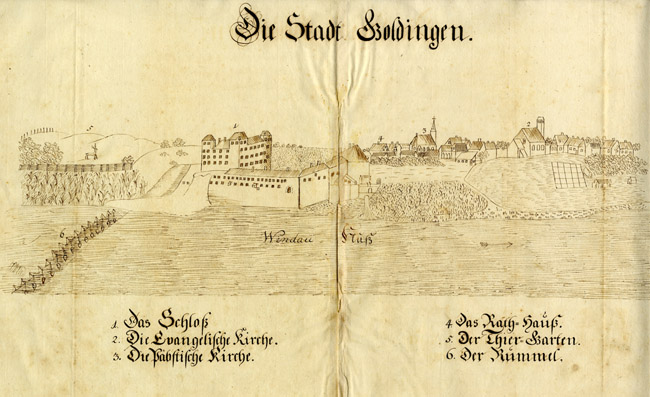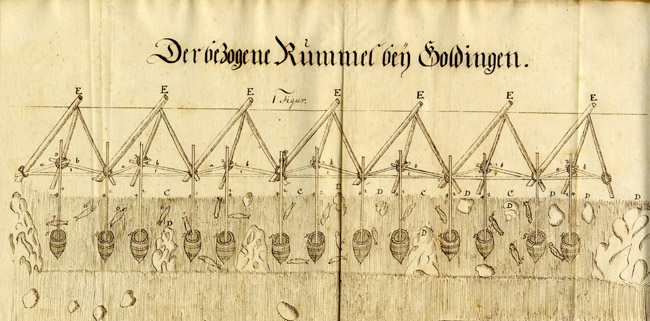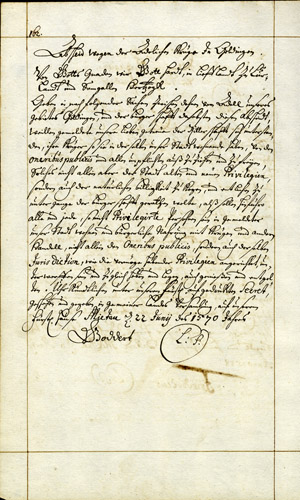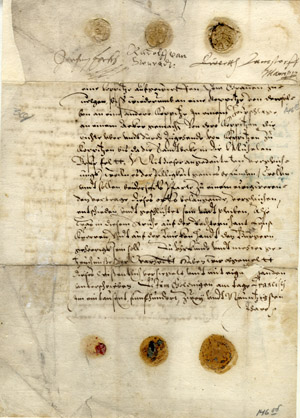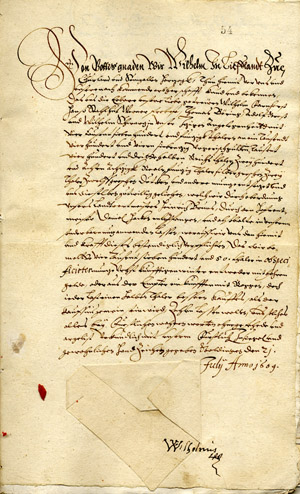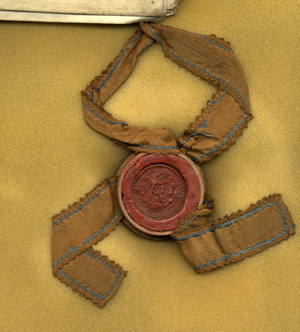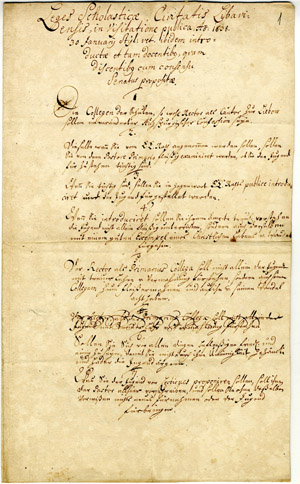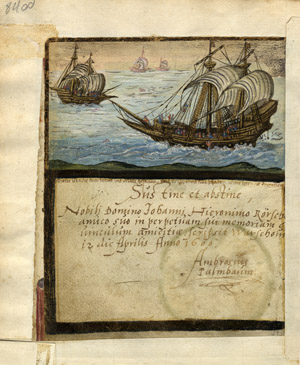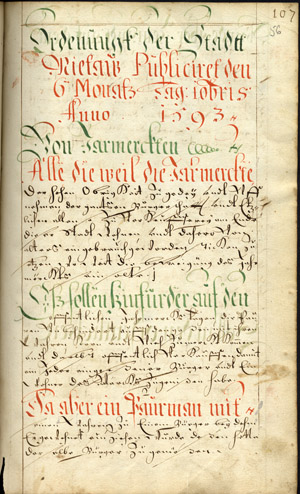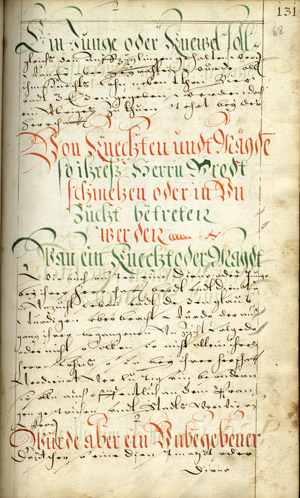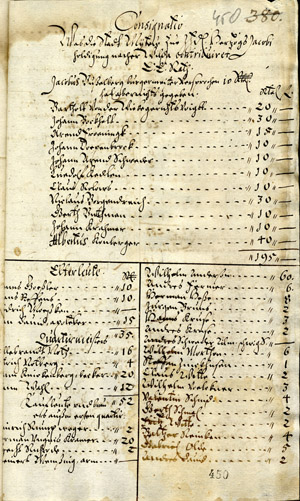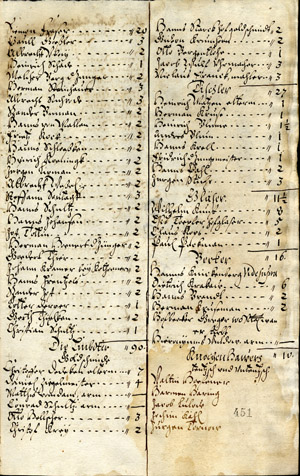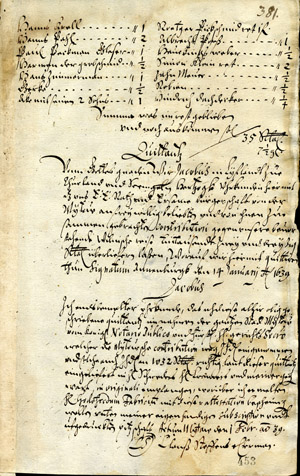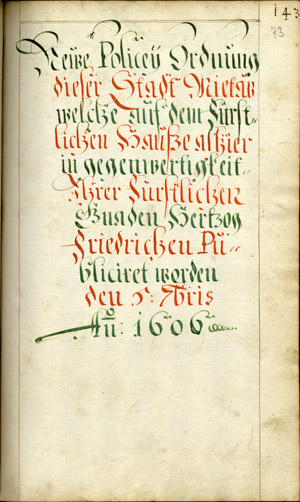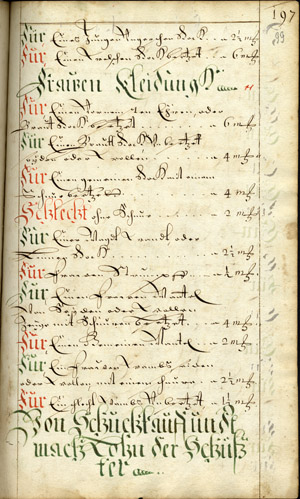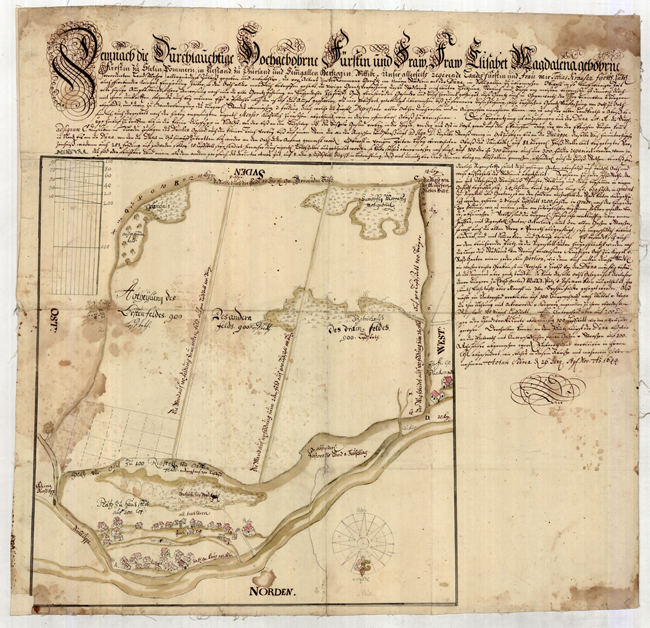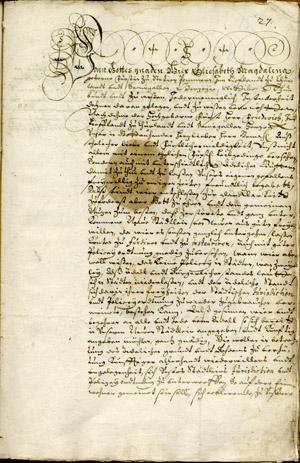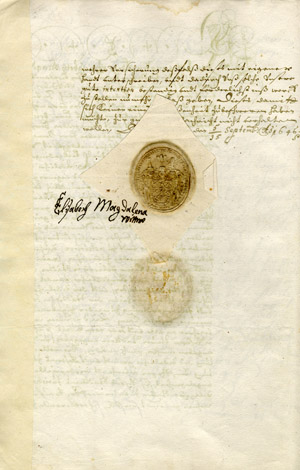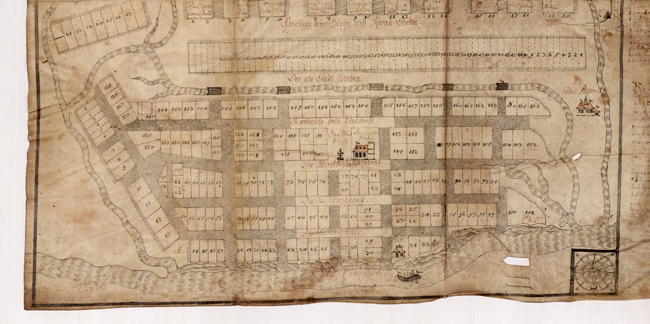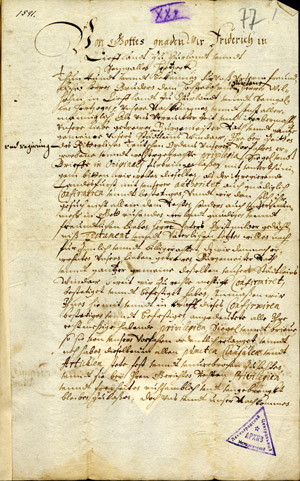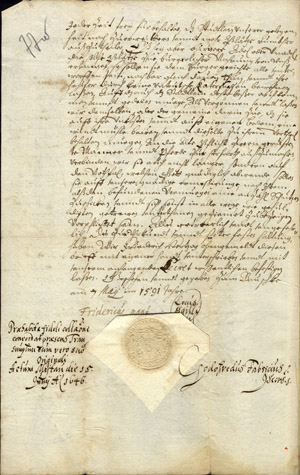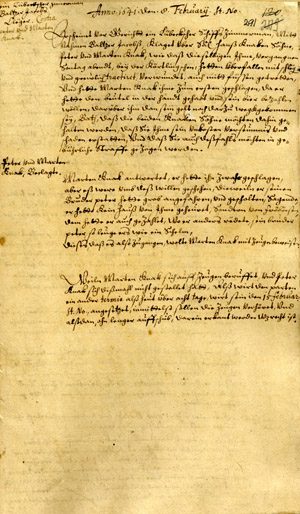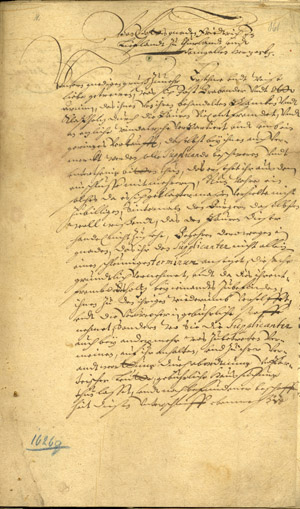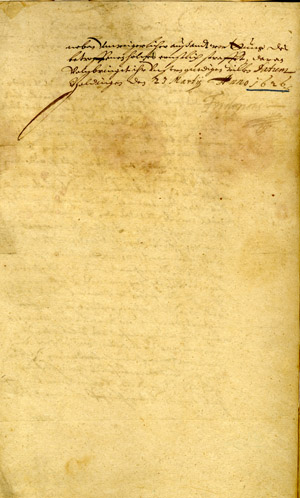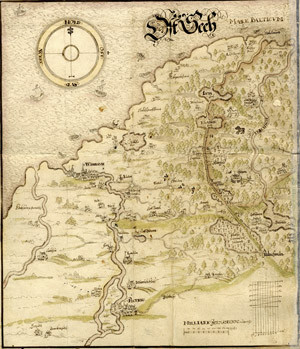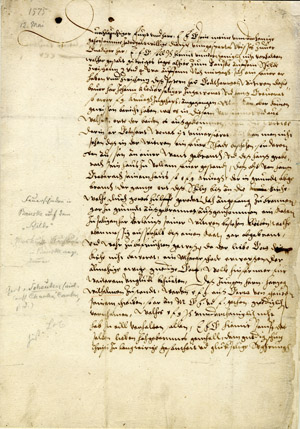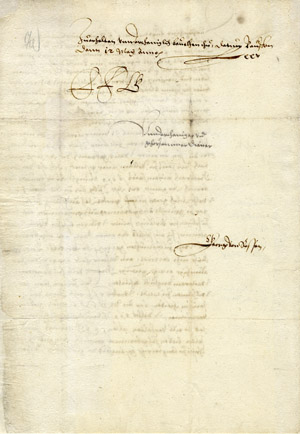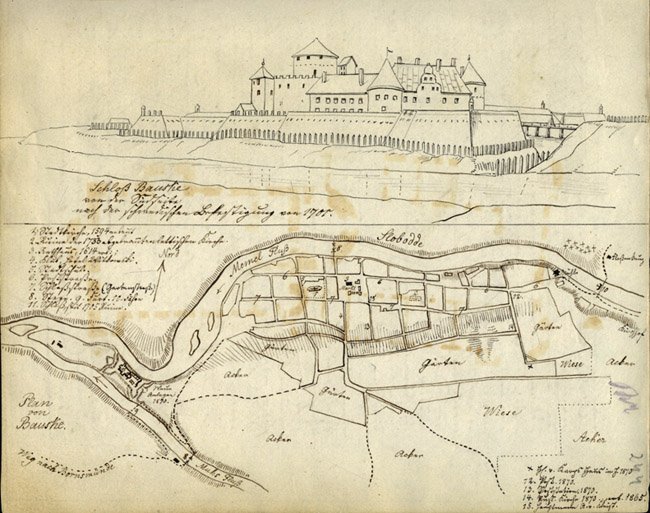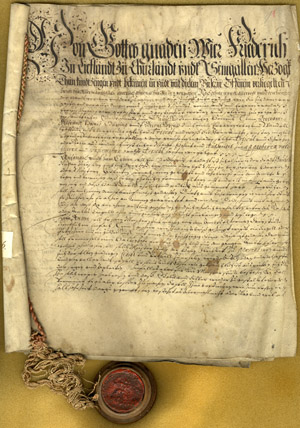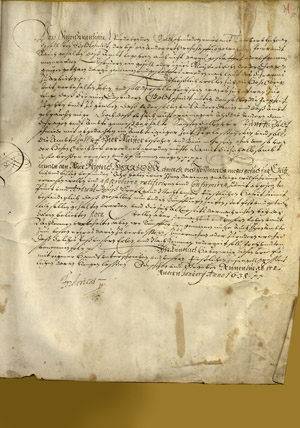The Towns of the Duchy
Up to the middle of the 17th century there were six towns in the Duchy of Courland: Goldingen/Kuldīga, Windau/Ventspils, Mitau/Jelgava, Libau/Liepāja, Bauske/Bauska and Neustädtchen or Friedrichstadt/Jaunjelgava. Later, Jacobstadt/Jēkabpils and Grobin/ Grobiņa also became towns. In many cases there was virtually no difference between the towns and townships in terms of the size of the population and the professions of the citizens. The most significant difference lay in the existence of special privileges and rights, which gave a population centre the status of a town and determined its administrative system. The privileges of the towns of the duchy were based on the ‘Laws of Riga’. All of the towns were under the supreme authority of the duke, who approved the candidates for the posts of town councillor, and issued and approved the town’s public order or police regulations. Unfortunately, the dukes were never able to achieve recognition of the town citizens as a politically independent section of the population. In the diet, the towns were represented by the duke, since the nobles refused to allow town representatives to take part.
1. Panorama of Goldingen/Kuldīga. 1730s. Drawing by Jonhann Georg Weigand. LVVA, Collection 7363, Inventory 3, File 951.
Goldingen/Kuldīga is the oldest town in Courland, having obtained its charter already in the mid-14th century. Initially, Duke Gotthard planned to establish his main residence here, but later he chose Mitau/Jelgava. Under the rule of Duke William, in 15951616, Goldingen/Kuldīga was the capital of the Courland part of the duchy. It retained the status of an official residence right up to 1642, when, at his accession to the throne, Duke James declared Mitau/Jelgava the sole capital. Interestingly, the Dukes Gotthard, William, James and Frederick Kasimir (16501698), returning to Courland after a wedding abroad, all went to Kuldīga first for a celebration. The figure 3 marks the Catholic church, construction of which James began in June 1641, fulfilling a promise given to the King of Poland. James had to buy up several plots belonging to citizens near the market square in order to fulfil the demand of the Catholic priests that the church be built in the centre of the town.
2. Catching fish at the River Windau/Venta Falls. 1730s. Drawing by Jonhann Georg Weigand. LVVA, Collection 7363, Inventory 3, File 951.
Although according to legend ‘catching fish in the air’ was invented by Duke James, this fishing method is presumably much older. According to Weigand, the ‘falls fishermen’ retrieved the fish that had fallen into the baskets three times a day and took them to the manor. About 80100 salmon and vimba bream could be caught in 24 hours. The German and Latvian pastors each were to receive 30 vimba bream from the first catch. The teacher was entitled to 15 fish, the sexton was to get 5 and each official of the manor was to be given 60 fish. The Dukes of Courland regarded fishing at the Windau/Venta Falls their privilege as rulers, i.e. a monopoly.
3. Decision of Duke Gotthard in a conflict between the citizens of Goldingen/ Kuldīga and the nobles. Mitau/Jelgava Castle, 22 June 1570. Copy. LVVA, Collection 7363, Inventory 3, File 471.
In 1567 Duke Gotthard had confirmed all of the old privileges of the town of Goldingen/Kuldīga, but the nobles considered that these were not binding on them. The innkeepers of inns belonging to the nobles refused to submit to the jurisdiction of the town council and strove to avoid fulfilment of duties for the town (onera publica), about which the Goldingen/Kuldīga citizens complained to the duke. Gotthard decided in favour of the townspeople. However, in all the towns of the duchy, conflicts between the nobility and the town citizens concerning privileges continued.
4. Record of an inspection of the boundary of the town of Goldingen/Kuldīga. 4 October 1592. LVVA, Collection 554, Inventory 3, File 1877.
The towns of the Duchy of Courland were not fortified, Mitau/Jelgava being an exception in this regard, protected by earthworks in the 1650s. However, every town had not only an urban area, but also a rural district with communal and private pasture, fields and meadows. The extent of the lands of the town is described in the descriptions of the town's boundaries and in boundary agreements. In this particular case the Captain of Goldingen/Kuldīga, Georg Fircks, together with two witnesses, had inspected the boundary markers erected on the boundary between the land belonging to the town of Goldingen/Kuldīga and the landholding of Ernst Knorre5. Promissory note of Duke William to residents of Libau/Liepāja. Goldingen/Kuldīga, 21 July 1609. LVVA, Collection 554, Inventory 1, File 70.
Duke William had borrowed money from residents of Libau/ Liepāja Wilhelm Farenhorst, Hans Stahlhut, Werner Frobese, Thomas Böring, Adolf Brass and Wilhelm Schwarz. The total debt was 4750 thalers in Hungarian guilders, state thalers, reales, silver groats and other coins. The duke promises to return the money during the coming winter, either in cash or in rye. However, the debt would only be paid by Duke James in 1643.
6. Privilege granted by Duke Frederick to Libau/Liepāja. Grobin/Grobiņa, 18 March 1625. Copy. Excerpt. LVVA, Collection 7363, Inventory 3, File 471.
In the year 15601609 the township of Libau/Liepāja, along with the rest of the Grobin/Grobiņa District, was under the rule of the Duke of Prussia. In spite of competition from the nearby port of Memel/Klaipeda, in the late 16th and early 17th century Libau/Liepāja successfully developed as a centre of commerce. In 1579, Georg Frederick, the Margrave of Brandenburg and Regent of Prussia issued a special trading law for Libau/Liepāja. However, Libau/Liepāja obtained its town charter only in 1625.
7. The seal of the town of Liepāja. 1625.
8. Libau/Liepāja town laws on schools. 30 January 1638 (old style). Copy. Excerpt. LVVA, Collection 650, Inventory 3, File 864.
The laws were approved by Hermann Dönhof, Captain of Durben/Durbe, the duke's Courtmarshal Albrecht Koschkull, Superintendent Paul Einhorn and the Dean of Grobin/Grobiņa District and the pastor of Schrunden/Skrunda Johann Grosskurz. Under the laws, the teachers the rector and cantor were to be nominated by the town council, and the local pastor was to assess the suitability of the candidates. When a teacher officially took up his duties, the pastor, in the presence of the town councillors, handed him a rod with which he was permitted to beat the pupils. Beating with fists or sticks was prohibited. The teachers and the parents of the pupils had to make sure that their children attended school. The parents had to respect the teachers, and in case of conflict with the parents, the teachers were not permitted to vent their anger on the children. The pastor had to inspect the school once a week and hold examinations twice a year. Each newly-hired teacher was to receive a copy of the laws.
9. Ships in the Baltic Sea. Drawing from 1600 in the memorial album of Johann Hieronymus Rörscheidt. LVVA, Collection 5759, Inventory 2, File 1403.
10. Public order or police regulations of Mitau/Jelgava town. Proclaimed 10 December 1593. Excerpt. LVVA, Collection 640, Inventory 3, File 627.
The town of Mitau/Jelgava was granted its charter in 1573, and in about 1590 police regulations were also issued, but these have not been preserved up to the present day. In 1593, the town council together with representatives of the citizens compiled a new volume of regulations for particular spheres of life in the town: the rules for trading at the annual market, the quality and price of meat, the wages of hired labourers, etc. The Latvians were prohibited from playing dice and cards in the inns, for which the innkeeper could be fined 5 marks and the gamblers thrashed. Manservants and maidservants caught engaged in debauchery in the house of their master were to be expelled from the town. Several of the regulations dealt with improvements in the town: board walkways were to be provided along the houses and inns, and 10 house-owners together had to provide a public well, where water was to be drawn for putting out fires. A guard of 7 men had to patrol at night.
11. List of the residents of Mitau/Jelgava. Early 1639. Excerpt. LVVA, Collection 554, Inventory 1, File 93.
The list includes the citizens who had paid an extraordinary tax or contribution. This money was intended to cover the expenses for Duke James' trip to Vilnius to receive his fief. Each citizen paid according to his own wishes and means. For example, it is noted that Town Mayor (Bürgermeister) Jakob Busselberg had promised to pay 10 thalers, but had given nothing, the bailiff (Vogt) Bartold von der Wieke had paid 30 thalers, and the rest of the town councillors had given 1040 thalers. Among the merchants, only Wilhelm Anderson had been particularly generous, giving 60 thalers. The most prestigious of the craft corporations, the Corporation of Goldsmiths, which, in addition to nine goldsmiths, also included the watchmaker Jakob Wulf and painter Nikolaus Franck, together collected 27 thalers, although two of the goldsmiths had been recognised as poor and did not pay at all. Most of the citizens gave a few thalers.
12. Receipt from Duke James. Annenburg/Emburga, 14 January 1639; affirmed by Claus Steffens, alderman of the town of Mitau/Jelgava. Mitau/Jelgava, 1 February 1639. Copies. LVVA, Collection 554, Inventory 1, File 93.
The money “given voluntarily” by the citizens of Mitau/Jelgava, totalling 1032 thalers, was handed over to the duke in Annenburg/Emburga by Godfried Fabricius, secretary of the Mitau/Jelgava court of first instance in the presence of town councillors Schweder and Krämer, and alderman Steffens. James issued a receipt for the money, which Fabricius handed to the alderman. Steffens affirmed that he had received it.
13. The new public order or police regulations of the town of Mitau/Jelgava. Proclaimed on 5 September 1606 in Mitau/Jelgava Castle in the presence of Duke Frederick. Excerpt. LVVA, Collection 640, Inventory 3, File 627.
The “New Police Regulations” approved by Duke Frederick, repeated the previous regulations almost entirely, along with a string of supplements, mainly relating to matters of town administration. For example, henceforth the town council had to include the Town Mayor (Bürgermeister), the bailiff (Vogt) and 10 councillors. The prices of products of several different crafts were laid down. For example, a bride’s gown cost 46 marks, an ordinary woman’s gown cost 24 marks, and stockings cost half a mark. Since the townspeople were not observing the earlier regulations on festivities and were still dressing too lavishly, the police regulations once again included articles regulating the dress, as well as weddings, christenings and funerals.
14. Plan of Neustädtchen/Jaunjelgava. Drawn by the duke’s court surveyor Tobias Krause. Sehren/Sērene, 26 June 1644. LVVA, Collection 183, Inventory 93, File 425.
This is the oldest known town plan from Courland. It depicts and describes the boundaries of the town, shows the extant buildings, two cemeteries and the planned division of the rural area. The annotation explains that when the town was founded, at the close of the 16th century, 81 plots of land had been measured out, and now 300 were planned. The surveyor sees the existing layout as chaotic: houses alternate with gardens, fields and threshing barns, and many of the plots have been ploughed up and sown with cereals. In re-establishing the town, the threshing barns, gardens and fields were to be arranged “on the German model” outside the town. Each plot had to have a “good” house, brewery, storehouse, stable and inn.
15. Declaration by Duchess Elisabeth Magdalena. Doblen/Dobele, 5/15 September 1646. LVVA, Collection 554, Inventory 1, File 1761.
The duchess announces her intention to re-establish the ‘New Township’ (Neustädtchen, Neues Städtlein), which had been destroyed in the war “out of gratitude towards the deceased duke, but especially to the glory of God and the general good” and to name it Friedrichstadt. The duchess also indicates that the nobles who live or in future will live in this town must affirm by their signature their readiness to submit to the jurisdiction of the town and its regulations.
16. Plan of Friedrichstadt/Jaunjelgava. Drawn by the duke’s court surveyor Tobias Krause on 23 October 1646. Detail of a copy made in 1786. LVVA, Collection 183, Inventory 93, File 425.
The town with its regular street network was created on the model of Renaissance examples. The main streets are the “Ordinary Country Highway”, Market Street, Russian Street and Daugava Street. At the centre of the town is a church and market square with a well. The plan also shows the pastorage, the duke’s customs house and the ferry.
17. Confirmation of the privileges granted to the town of Windau/Ventspils by Duke Frederick. Bauske/Bauska, 7 May 1591. Authorised copy. LVVA, Collection 554, Inventory 1, File 61.
At the behest of the townspeople, Duke Frederick confirms all of the previous privileges granted to Windau/Ventspils and grants permission for the construction of a windmill on the land of the town. The duke retains the right “to extend the town as much as possible”, but with the proviso that the owners of the plots of land that were granted must submit to the jurisdiction and regulations of the town. Frederick also frees Windau/Ventspils from its old obligation of sending two armed riders to the duke in case of war. Instead, henceforth it was to send as many musketeers as possible.
18. Court record of the Bailiff (Vogt) of Windau/Ventspils. 8 February 1641. LVVA, Collection 646, Inventory 1, File 1.
Lübeck ship's carpenter Balzer Jacobs had brought before the court a complaint about two local people, the brothers Martin and Peter Knak, who, he said, had beaten him up the previous Sunday. Jacobs had wanted to pay for beer, when Martin had come up and started hitting him. He had also knocked his purse from his hands, the money had fallen out and could not be regained. Jacobs demanded that the brothers compensate his losses, the bodily harm they hade done and the dishonour, and should be duly punished. Martin said that he had hit Jacobs because the latter had gravely insulted his brother, and said he had witnesses to prove it. Since Martin claimed he had witnesses and Peter Knak was not present at court, it was decided that the trial should be adjourned and that the witnesses should first be interrogated.
19. Instruction from Duke Frederick to Windau/Ventspils Town Council. Goldingen/Kuldīga, 23 March 1626. LVVA, Collection 646, Inventory 1, File 1.
The merchants Jost Brabender and Otto Arnim had complained to the duke that peasants had stolen a large proportion of the oak planks they had bought and had sold them to certain Windau/Ventspils merchants. Since it was well known to the people of Windau/Ventspils that peasants were prohibited from trading in timber, the duke orders the town council to undertake an investigation, searching the homes and warehouses of the suspects, returning the timber to the owner and punishing the perpetrators.
20. Windau/Ventspils and the surrounding area. Detail of a plan to regulate the boundaries of the manors of Pussen/Puze, Popen/Pope and Rothof/Ventspils muiža, drawn by the duke's surveyor T. Krause. 9 May 1640. LVVA, Collection 1100, Inventory 1, File 70.
Windau/Ventspils is the second oldest town in the duchy. Very close to the town was Rothof/Sarkanmuiža or Windau/ Ventspils-Manor, and on the opposite bank of the river was Kusten/Kuste. In the early 17th century, when Rothof/Sarkanmuiža was owned by Kaspar von der Ley, Kusten/Kuste was its stock farm. Later, in about 1618, when Rothof/Sarkanmuiža was purchased by Duke Frederick, Kusten/Kuste was separated from it and granted as a fief to Tillmann Jaspers, the Town Mayor (Bürgermeister) of Windau/ Ventspils. In the late 17th century it was repurchased by Duke Frederick Kasimir.
21. Letter from the Georg von Rosen, Captain of Bauske/Bauska, to Duke Gotthard. Bauske/Bauska, 12 May 1575. LVVA, Collection 554, Inventory 1, File 1884.
Rosen reports that the previous day between 3.00 and 4.00 in the afternoon a large fire had broken out in the ‘shield township’ of Bauske/Bauska (aufm Schilde). Almost the entire township had burned down, except for the church, which had begun to burn, but “had been saved through the grace of God”. He reports that the fire began in the inn belonging to the duke.
22. Plan of the town of Bauske/Bauska. 19th century drawing by Julius Döring. LVVA, Collection 5759, Inventory 2, File 1107.
In the 1580s the township of Bauske/Bauska was transferred from the peninsula to the bank of the River Memel/Mēmele. The highway from Lithuania to Riga, passing through Bauske/Bauska, promoted the growth of the township, but because of the confusion of the war, Bauska received its town charter relatively late in 1635. In accordance with the police regulations approved by Duke Frederick, the town council was to include the Town Mayor (Bürgermeister), bailiff (Vogt) and five councillors. Bauske/Bauska was the only one of the duke’s towns where use of the “great Lithuanian measure” was permitted, while in the rest of the duchy the Riga measures were to be used. Döring has copied the depiction of Bauske/Bauska Castle from an early 18th century engraving. Clearly visible in the foreground is the block of the castle built in the 1590s, with a Late Renaissance style gable.
23. Statute of the Bauske/Bauska Goldsmiths. Parchment. Excerpt. Approved at Annenburg/Emburga, 2 January 1638. LVVA, Collection 4038, Inventory 2, File 1157.
At the request of Bauske/Bauska goldsmiths Heinrich Tinne, Bertram Hilbrandt, Hans Garding and Berendt Boyenss, Duke Frederick approves the statute they have submitted. It was modelled on the Mitau/Jelgava goldsmiths' statute, with the differences that Bauske/Bauska had fewer masters. Thus, the corporation was to include four master craftsmen. The duke had the right to include in the corporation one more goldsmith, according to his own wishes. Unlike other professions, the goldsmith's craft was to be mastered not in one year, but in three. During this time a journeyman had to work for one or, at most, two masters. In order to obtain the rights of a master, the journeyman had to submit three masterpieces: a simple silver drinking vessel, a gold ring with a transparent stone and a die for a seal. A period of six months was granted for making these. If the alderman of the guild regarded the masterpiece as being of poor quality, the journeyman could make a second attempt after another six months.